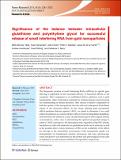| dc.contributor.author | McCully, Mark | |
| dc.contributor.author | Hernandez, Yulan | |
| dc.contributor.author | Hursthouse, Andrew | |
| dc.contributor.author | Stirling, David | |
| dc.contributor.author | Baptista, Pedro V. | |
| dc.contributor.author | de la Fuente, Jesus M. | |
| dc.contributor.author | Berry, Catherine C. | |
| dc.contributor.author | Osorio De Castro Conde, Joao | |
| dc.date.accessioned | 2016-12-02T22:15:36Z | |
| dc.date.available | 2016-12-02T22:15:36Z | |
| dc.date.issued | 2015-08 | |
| dc.date.submitted | 2015-06 | |
| dc.identifier.issn | 1998-0124 | |
| dc.identifier.issn | 1998-0000 | |
| dc.identifier.uri | http://hdl.handle.net/1721.1/105547 | |
| dc.description.abstract | The therapeutic promise of small interfering RNAs (siRNAs) for specific gene silencing is dependent on the successful delivery of functional siRNAs to the cytoplasm. Their conjugation to an established delivery platform, such as gold nanoparticles, offers tremendous potential for treating diseases and advancing our understanding of cellular processes. Their success or failure is dependent on both the uptake of the nanoparticles into the cells and subsequent intracellular release of the functional siRNA. In this study, utilizing gold nanoparticle siRNA-mediated delivery against C-MYC, we aimed to determine if we could achieve knockdown in a cancer cell line with low levels of intracellular glutathione, and determine the influence, if any, of polyethylene glycol (PEG) ligand density on knockdown, with a view to determining the optimal nanoparticle design to achieve C-MYC knockdown. We demonstrate that, regardless of the PEG density, knockdown in cells with relatively low glutathione levels can be achieved, as well as the possible effect of steric hindrance of PEG on the availability of the siRNA for cleavage in the intracellular environment. Gold nanoparticle uptake was demonstrated via transmission electron microscopy and mass spectroscopy, while knockdown was determined at the protein and physiological levels (cells in S-phase) by in-cell westerns and BrdU incorporation, respectively. | en_US |
| dc.publisher | Tsinghua University Press | en_US |
| dc.relation.isversionof | http://dx.doi.org/10.1007/s12274-015-0828-5 | en_US |
| dc.rights | Article is made available in accordance with the publisher's policy and may be subject to US copyright law. Please refer to the publisher's site for terms of use. | en_US |
| dc.source | Tsinghua University Press | en_US |
| dc.title | Significance of the balance between intracellular glutathione and polyethylene glycol for successful release of small interfering RNA from gold nanoparticles | en_US |
| dc.type | Article | en_US |
| dc.identifier.citation | McCully, Mark, Yulan Hernandez, João Conde, Pedro V. Baptista, Jesus M. de la Fuente, Andrew Hursthouse, David Stirling, and Catherine C. Berry. “Significance of the Balance Between Intracellular Glutathione and Polyethylene Glycol for Successful Release of Small Interfering RNA from Gold Nanoparticles.” Nano Research 8, no. 10 (August 28, 2015): 3281–3292. | en_US |
| dc.contributor.department | Institute for Medical Engineering and Science | |
| dc.contributor.department | Harvard University--MIT Division of Health Sciences and Technology | |
| dc.contributor.mitauthor | Osorio De Castro Conde, Joao | |
| dc.relation.journal | Nano Research | en_US |
| dc.eprint.version | Author's final manuscript | en_US |
| dc.type.uri | http://purl.org/eprint/type/JournalArticle | en_US |
| eprint.status | http://purl.org/eprint/status/PeerReviewed | en_US |
| dc.date.updated | 2016-08-18T15:47:09Z | |
| dc.language.rfc3066 | en | |
| dc.rights.holder | Tsinghua University Press and Springer-Verlag Berlin Heidelberg | |
| dspace.orderedauthors | McCully, Mark; Hernandez, Yulan; Conde, João; Baptista, Pedro V.; de la Fuente, Jesus M.; Hursthouse, Andrew; Stirling, David; Berry, Catherine C. | en_US |
| dspace.embargo.terms | N | en |
| dc.identifier.orcid | https://orcid.org/0000-0001-8422-6792 | |
| mit.license | PUBLISHER_POLICY | en_US |
